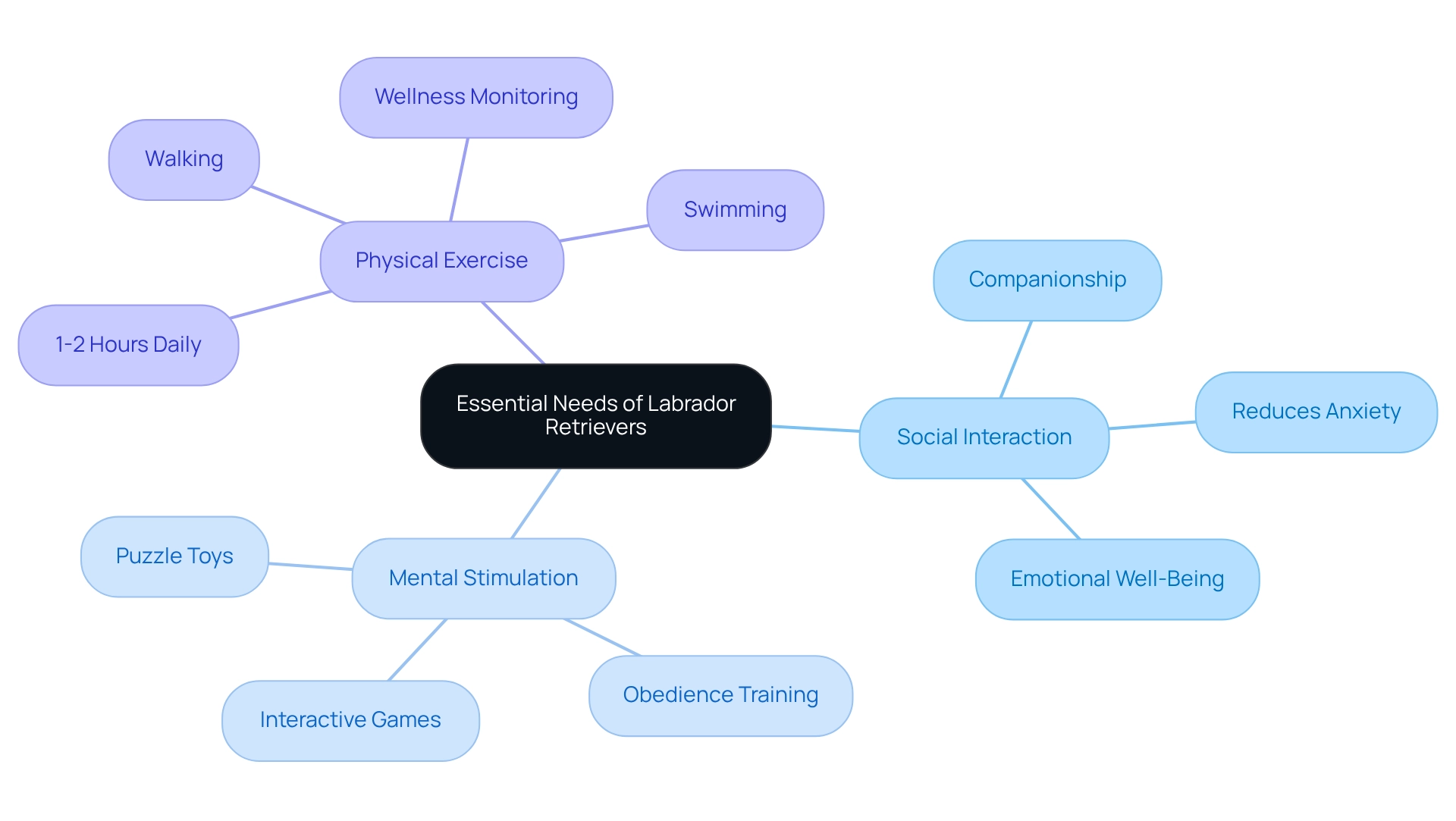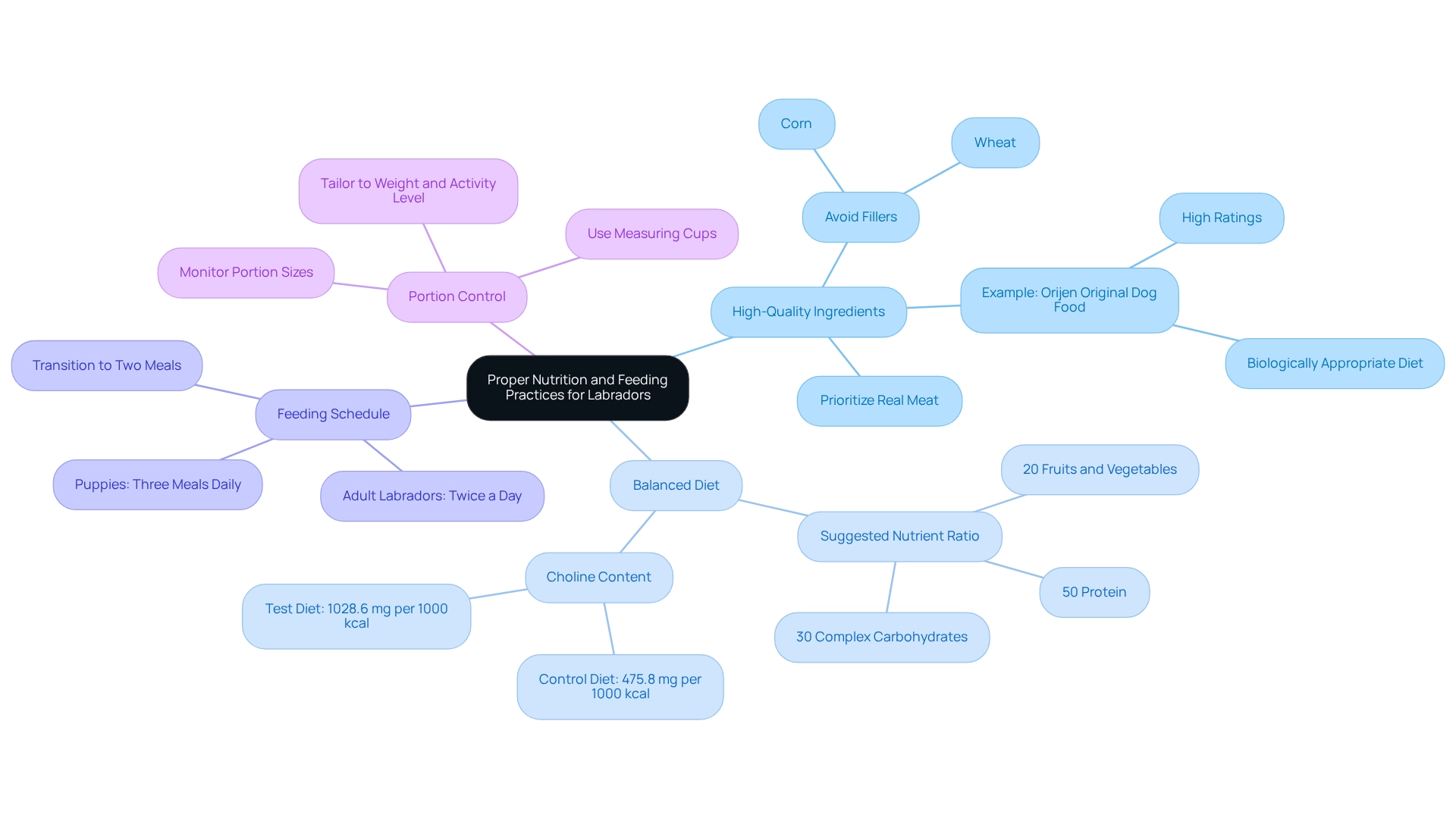
4 Essential Practices for Caring for Your Labrador Retriever
Overview
Caring for your beloved Labrador Retriever involves more than just meeting basic needs; it’s about fostering a deep connection through:
- Proper social interaction
- Mental stimulation
- Physical exercise
- A balanced diet
We understand how much you care about your furry friend, and it’s crucial to address these needs with:
- Regular engagement
- Quality nutrition
- Proactive health monitoring
By doing so, you not only help your Labrador lead a happy and healthy life but also strengthen the beautiful bond you share. Remember, you’re not alone in this journey; we’re here to support you every step of the way.
Introduction
Labrador Retrievers, with their friendly demeanor and boundless energy, deserve our love and companionship, but they require so much more to truly thrive. It’s essential to understand their needs, as this knowledge is vital for nurturing a fulfilling life for these intelligent dogs.
Every aspect of their care—from social interaction and mental stimulation to proper nutrition and regular exercise—plays a crucial role in their overall well-being.
In this article, we will explore the fundamental requirements of Labrador Retrievers, offering insights and practical tips to help owners ensure their furry companions lead happy, healthy lives.
By prioritizing these essential needs, pet owners can create a nurturing environment that supports both the physical and emotional health of their beloved Labradors, fostering a deep bond that enriches both their lives.
Understand the Essential Needs of Labrador Retrievers
Labrador Retrievers are cherished for their friendly nature, high energy, and remarkable intelligence. As devoted pet owners, it’s essential to recognize and address their fundamental needs to ensure they lead fulfilling lives. These needs include:
-
Social Interaction: Social interaction is essential for a labrador retriever, as they are inherently social creatures that thrive on companionship. Regular interaction with humans and other dogs is crucial to prevent the loneliness that can lead to behavioral issues. Recent studies have shown that socialization significantly reduces anxiety and fosters a balanced temperament in labrador retrievers, which are known to be wonderful dogs. The Kennel Club Charitable Trust emphasizes that nurturing social connections is vital for their emotional well-being.
-
Mental Stimulation: With their high intelligence, these dogs require engaging mental challenges to stay happy and fulfilled. Activities like puzzle toys, obedience training, and interactive games are not just beneficial; they are essential for their cognitive development and overall joy. By participating in these stimulating activities, you can help mitigate the risk of behavioral problems that often arise from boredom.
-
Physical Exercise: Physical exercise is crucial for a labrador retriever, as these energetic dogs need substantial physical activity—ideally, 1-2 hours each day. This can include walks, runs, swimming, and playtime, all of which contribute to their physical health and help prevent common issues like obesity. Recent news highlights that the Labrador retriever breed exhibits different disorder profiles compared to non-Labrador retrievers, showing a predisposition to conditions like osteoarthritis, making regular exercise even more critical for their well-being. Wellness monitoring for a Labrador Retriever includes regular veterinary check-ups, which are essential for tracking common health issues such as hip dysplasia and obesity. A recent case study titled ‘Understanding Breed-Specific Health Risks’ sheds light on the risks associated with Retrievers, underscoring the importance of proactive wellness management. The likelihood of being diagnosed with at least one disorder remains consistent between Retrievers of this breed and others (OR 1.00), highlighting the need for careful monitoring of their health.
By addressing these core needs with love and attention, you can create a nurturing environment that fosters the well-being and happiness of your beloved retrievers.

Implement Proper Nutrition and Feeding Practices
The unique dietary needs of a Labrador Retriever are essential for their well-being and vitality. As caring pet owners, it’s natural to want the best for our furry friends. Here are some best practices for feeding your beloved Labrador:
-
High-Quality Ingredients: Choosing dog food that prioritizes real meat—like chicken, fish, or lamb—as the primary ingredient is vital. It’s important to avoid products with fillers such as corn and wheat, which provide little nutritional value. For instance, Orijen Original Dog Food showcases a biologically suitable diet, utilizing premium ingredients to support the health of dogs at any age.
-
Balanced Diet: A well-rounded diet should include a thoughtful mix of proteins, fats, and carbohydrates. For a Labrador Retriever, a suggested ratio of their diet is approximately 50% protein, 30% complex carbohydrates, and 20% fruits and vegetables. This balance ensures they receive the essential nutrients for optimal health. Notably, the Control diet for the Labrador Retriever contained 475.8 mg of choline per 1000 kcal, whereas the Test diet had 1028.6 mg, underscoring the significance of specific nutrients in a Labrador Retriever’s diet.
-
Feeding Schedule: To help prevent overeating, adult retrievers should ideally be fed twice a day. Puppies, however, may benefit from three meals daily, gradually transitioning to two as they grow. This approach not only supports their nutritional needs but also fosters a routine that can bring comfort to both you and your pup.
-
Portion Control: It’s crucial to monitor portion sizes carefully to combat obesity, a common concern among this breed. Using measuring cups can assist in ensuring accurate feeding amounts tailored to your dog’s weight and activity level, allowing you to support their health effectively.
As Martin Buxbaum wisely said, “A dog wags its tail with its heart.” By following these nutritional guidelines, you can help your Labrador Retriever maintain a healthy weight and energy level, ultimately enhancing their overall well-being. Remember, your love and attention play a significant role in their happiness and health.

Prioritize Regular Exercise and Socialization Activities
Labrador retrievers truly thrive when they receive ample exercise and social interaction, both of which are vital for their overall health and happiness. As a caring pet owner, you might be wondering how to weave these essential elements into your dog’s daily routine. Here are some thoughtful strategies to consider:
-
Daily Exercise: Strive for at least 1-2 hours of exercise each day, with a minimum of one hour being essential. Activities like walking, running, swimming, and playing fetch are not just enjoyable; they are crucial for your labrador retriever’s well-being. By mixing different types of exercise, you can keep your labrador retriever engaged and excited, which helps prevent joint issues and ensures that your labrador retriever remains mentally stimulated.
-
Interactive Play: Delight in games that engage both the mind and body, such as tug-of-war, hide-and-seek, or agility training. These activities not only provide physical exercise but also strengthen the bond between you and your dog, enhancing their emotional health. Remember to vary these activities to maintain your labrador retriever’s interest and prevent any potential joint problems, as your pet deserves the best.
-
Socialization opportunities: Consider organizing playdates with other dogs or visiting pet parks to allow your labrador retriever to interact with their peers. This exposure is essential for developing the social skills of a labrador retriever and reducing the likelihood of behavioral issues, fostering a well-adjusted pet. Additionally, joining a community for training support, as suggested by BJ Ganem, can further enrich your dog’s socialization experiences.
-
Training Classes: Enrolling your dog in obedience or agility classes can be a wonderful way to provide both exercise and mental stimulation. These sessions also offer valuable socialization opportunities with other dogs and people. It’s best to start building your labrador retriever’s fitness once they reach 18 months old, ensuring they are ready for more rigorous activities. By prioritizing regular exercise and socialization, you can ensure your beloved labrador retriever remains a happy, healthy, and well-adjusted companion. Your dedication to their well-being not only enriches their lives but also deepens the bond you share.

Maintain Grooming Routines and Monitor Health Issues
Grooming and wellness monitoring are essential for the well-being of our beloved labrador retriever. As pet owners, it’s natural to worry about their health and happiness, and understanding the best practices can make all the difference in their lives.
Regular brushing is necessary as labrador retrievers tend to shed moderately to heavily, especially during seasonal changes. To help minimize shedding and prevent matting, it’s advisable to brush your labrador retriever at least once a week. During peak shedding periods, daily brushing can keep the coat of your labrador retriever healthy and manageable, allowing you to enjoy those precious moments together without the worry of fur everywhere.
-
Bathing: Aim to wash your dog every 4-6 weeks, or as needed, using a high-quality canine shampoo that nurtures their coat. It’s important to be cautious not to overbathe, as this can strip away the natural oils that are vital for maintaining a healthy coat. Think of bath time as a bonding experience, a chance to show your furry friend just how much you care.
-
Wellness check-ups: Scheduling yearly veterinary appointments for a labrador retriever is crucial for monitoring common concerns like hip dysplasia, obesity, and skin conditions. Retrievers are known to be predisposed to 67 diseases, making early detection key to effective treatment and management. By staying proactive, you can ensure your dog receives the best care possible, which ultimately brings peace of mind.
-
Dental Care: Regular dental hygiene is vital for your Lab’s overall health. Brushing their teeth regularly and providing dental chews can promote good oral care. Remember, neglecting dental health can lead to serious complications over time, so taking these small steps can have a significant impact on their well-being.
It’s also important to recognize that a Labrador retriever may face various medical concerns, such as arthritis, as they age. A case study on arthritis in aging labrador retrievers highlights that regular exercise and weight management are crucial in alleviating symptoms. Joint supplements, like Dasuquin with MSM, can also support their joint health. By adhering to a regular grooming regimen and proactive wellness monitoring, you can significantly enhance your dog’s quality of life.
As one Amazon customer noted, ‘Not a very informative book,’ highlighting the importance of seeking reliable information on proper care for Labrador Retrievers. This underscores the need for pet owners to be well-informed about their pets’ health and grooming needs, ensuring that you can provide the love and care your furry companions deserve.

Conclusion
Labrador Retrievers are truly remarkable companions, deserving of the dedicated care that allows them to thrive. As an owner, understanding their essential needs—social interaction, mental stimulation, physical exercise, and health monitoring—can help you create an environment that promotes their happiness and well-being.
- Regular socialization is key to preventing loneliness and behavioral issues, while mental challenges keep their intelligent minds engaged.
- Adequate exercise is vital for maintaining their physical health, especially given their predisposition to certain health conditions.
Nutrition plays a pivotal role in your Labrador’s life as well. By providing high-quality ingredients, balanced diets, and careful portion control, you can help prevent obesity and ensure they receive the necessary nutrients for optimal health.
- Additionally, establishing a consistent feeding schedule helps regulate their appetite and energy levels, contributing to their overall well-being.
Moreover, regular grooming and health check-ups are crucial for identifying potential health issues early on. By adhering to a structured grooming routine and being vigilant about their health, you can significantly enhance your Labrador’s quality of life.
Ultimately, the bond between you and your Labrador can flourish when these fundamental needs are met. Prioritizing their care not only enriches their lives but also fosters a lasting companionship that brings joy to both your dog and your family. Embracing these practices ensures that Labrador Retrievers lead fulfilling, healthy lives, making them the wonderful companions they are known to be.

